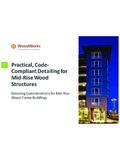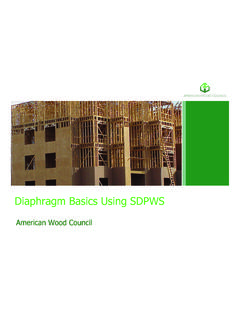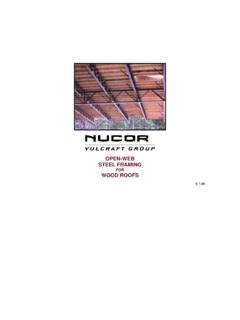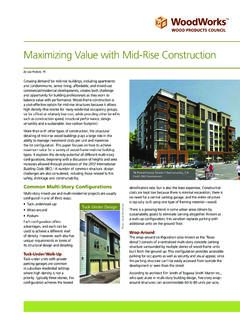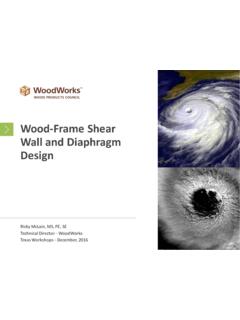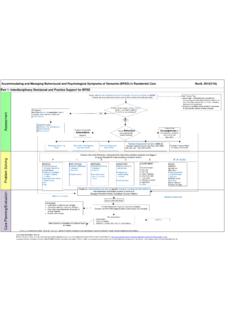Transcription of Accommodating Shrinkage in Multi-Story Wood-Frame …
1 In Wood-Frame buildings of three or more stories, cumulative Shrinkage can be significant and have an impact on the function and performance of finishes, openings, mechanical/electrical/plumbing (MEP) systems, and structural connections. However, as more designers look to Wood-Frame construction to improve the cost and sustainability of their mid-rise projects, many have learned that Accommodating wood Shrinkage is actually very straightforward. Wood is hygroscopic, meaning it has the ability to absorb and release moisture. As this occurs, it also has the potential to change dimensionally. Knowing how and where wood shrinks and swells helps designers detail their buildings to minimize related Shrinkage occurs perpendicular to grain, meaning that a solid sawn wood stud or floor joist will shrink in its cross-section dimensions (width and depth). Longitudinal Shrinkage is negligible, meaning the length of a stud or floor joist will essentially remain unchanged.
2 In Multi-Story buildings, wood Shrinkage is therefore concentrated at the wall plates, floor and roof joists, and rim boards. Depending on the materials and details used at floor-to-wall and roof-to-wall intersections, Shrinkage in light- frame wood construction can range from inches to inches per level. This publication will describe procedures for estimating wood Shrinkage and provide detailing options that minimize its effects on building Science & ShrinkageUnderstanding the cellular structure of wood allows us to understand how moisture and wood interact and identify the paths that moisture typically travels. Within wood, moisture is present in two forms: (1) free water in cell cavities, and (2) bound water in cell walls. Simplistically, wood s cellular structure can be imagined as a bundle of drinking straws held together with a rubber band, with each straw representing Accommodating Shrinkage in Multi-Story Wood-Frame StructuresRichard McLain, MS, PE, SE, Technical Director, WoodWorks Doug Steimle, PE, Principal, Schaefera longitudinal cell in the wood.
3 Water can be free water stored in the straw cavity or bound water absorbed by the straw walls. At high moisture contents, water exists in both locations. As the wood dries, the free water is released from the cell cavities before the bound water is released from the cell walls. When wood has no free water and yet the cell wall is still saturated, it is said to be at its fiber saturation point (FSP). Imagine a sponge that has just been taken out of a bucket filled with water. As the sponge is lifted from the bucket, water comes out of the pores. When the sponge is squeezed, more water comes out of the pores. The moment when no water can be squeezed out of the sponge but yet it still feels damp is analogous to the FSP. The moisture retained in the sponge is the bound water and water that has been squeezed out is the free water. The Brooklyn RiversideJacksonville, FloridaArchitect: Dwell Design StudioStructural Engineer: M2 Structural EngineeringPhoto: Pollack Shores, Matrix Residential$ 18/9/17 2:20 PMMoisture ContentWood moisture content (MC) is the weight of water in wood as a percentage of the completely dry wood weight.
4 During the life of a tree, its MC can exceed 200 percent, meaning the total water weight in a given volume of wood makes up two thirds or more of the total weight. The FSP of different species of wood varies but for most common softwoods is around 28-30 percent. The MC of lumber in service is typically 7-14 percent, much lower than the FSP. Wood remains dimensionally stable above the FSP; , it doesn t change in dimension with an increase or decrease of moisture as long as it remains above the FSP at all times. This is because the water being absorbed or released is largely free water, not bound water. Once the moisture content drops below the FSP ( , bound water is being removed), the wood starts to change dimensionally. Since water is now being released from cell walls, both the walls and surrounding structure shrink, causing the overall cross-section of wood to shrink. For structural wood members, the MC of the wood is reduced after milling, either by air or kiln a side note, moisture absorption has the opposite effect expansion.
5 As the MC of a piece of wood increases (up to the point that it reaches its FSP), it will expand in cross-section based on the same principles (increase of bound water).While wood Shrinkage is noticeable in both cross-section dimensions (width and depth), the two are typically not equal. Wood shrinks most in the direction tangential to the growth rings, and about half as much in the radial direction (see Figure 1). Table 13-5 of the Wood Handbook1 published by the USDA Forest Products Laboratory provides Shrinkage values for a number of softwood species (see Figure 6). Wood Shrinkage can be calculated using exact grain orientation and species-dependent Shrinkage coeffi cients. However, it is impossible to predict grain orientation (tangential, radial or a combination) of members such as wall plates and fl oor joists. Due to this, it is either assumed that both radial and tangential grain orientation will be present and the amount of Shrinkage will be an average of the two or the worst case of all tangential grain orientation is most structural applications, a simplifi ed method is considered suffi ciently accurate.
6 The common approximation is that wood shrinks 1 percent in the cross-sectional dimension for every 4 percent MC change from 0-30 This translates to a dimensional change of inches per inch of cross-sectional dimension for every 1 percent change in MC. An example calculation using this technique is included in the section Calculating Shrinkage beginning on page Wood-Frame construction, the three variables infl uencing the magnitude of Shrinkage are:1. Installed MC2. In-service MC or equilibrium moisture content (EMC)3. Cumulative thickness of cross-grain wood elementsInitial MC, or MC at the time of manufacture, is typically specifi ed on a project s structural drawings. In many parts of the country, the specifi cation would read a maximum MC of 19 percent. In order to achieve this, lumber is generally kiln dried. Although there are regional variations, less commonly used green lumber (which typically hasn t been kiln dried and has a MC above 19 percent), surface dried lumber or KD-15 ( , kiln dried lumber with a maximum MC of 15 FIGURE 1:Moisture content- Shrinkage curvesSouthern yellow pine cellular makeup Source: USDA Forest Service Agricultural Handbook (1972)Source: RDH Building Science $ 28/9/17 2:20 PMinevitable Shrinkage (see Figure 2).)
7 EMC is a function of temperature and relative humidity as shown in Figure 3. It is worth noting that EMC is a dynamic equilibrium, meaning it can change throughout the year with climate changes. It also varies across the country based on local climatic conditions (see Figure 4). Generally, for wood exposed to exterior (non-conditioned) atmospheric conditions, variations in EMC of 1-3 percent exist between the driest months and wettest months. The EMC of wood within a conditioned building follows the same trends but varies with interior conditions. Typically, the average annual EMC for a given project s climate is used for Shrinkage estimation purposes. Several examples exist of projects that have tracked lumber moisture content fluctuations, both during construction and after 2:Moisture content rangeKey TermsDry lumber Lumber of less than nominal 5-inch thickness which has been seasoned or dried to a maximum moisture content of 19 percentEquilibrium moisture content (EMC) The moisture content at which wood neither gains nor loses moisture when surrounded by air at a given relative humidity and temperature Green lumber Lumber of less than nominal 5-inch thickness which has a moisture content in excess of 19 percent or, for lumber of nominal 5-inch or greater thickness (timbers), as defined in accordance with applicable lumber grading rules Sources: (left) Western Wood Products Association (WWPA); (right) Northeastern Lumber Manufacturers Association (NELMA)percent at time of manufacture) may also be specified.
8 The American Softwood Lumber Standard, PS 20-15, defines dry lumber as lumber of less than nominal 5-inch thickness which has been seasoned or dried to a maximum moisture content of 19 percent. Engineered wood products, including wood structural panels such as plywood and oriented strand board (OSB), glued-laminated timber (glulam) and structural composite lumber (SCL), are manufactured with lower moisture contents, in the range of 2-15 percent. Engineered wood manufacturers generally provide initial moisture contents for their that has been dried to a maximum MC of 19 percent at the time of manufacture does not necessarily maintain that MC over the course of its pre-construction life (distribution, transport and storage), nor does it necessarily stay at that same MC for the duration of construction. It is possible for the pre-construction or construction-phase MC of framing members to rise significantly above 19 percent if they are not protected well. Proper protection of the lumber, both when stockpiled on site and after installation, is critical to good performance.
9 See the section Minimizing Shrinkage below for ways to avoid moisture accumulation during construction. Designers may also consider specifying a maximum MC at the time of installation as this is the value that will provide a more accurate Shrinkage calculation. Ideally the MC should be measured at time of installation and compared to initial close-in, the framing in a conditioned building eventually reaches its in-service MC, or EMC, in the range of 7-15 percent. Until that point, the wood framing is subject to Grade Stamp Markings:S-GRN: surfaced greenS-DRY: surfaced dryKD: kiln driedHT: heat treatedHeat treated (HT) Lumber or other wood product that has been heated in a closed chamber, with or without moisture content reduction, until it achieves a minimum core temperature of F for a minimum of 30 minutes Kiln dried (KD) Lumber that has been seasoned in a chamber to a predetermined moisture content by applying heat Moisture content (MC) The weight of the water in a piece of lumber expressed in a percentage of the weight of the piece after being oven dried Fiber saturation point (FSP) The point in drying wood at which all free moisture has been removed from the cell itself while the cell wall remains saturated with absorbed moistureSource: RDH Building Science (High)Initial MCIn-Service (Low)MOISTURE CONTENT (%)Example lumber grade stampsKD-HTSTUDSPFs3$ 38/9/17 11:46 AMFIGURE 3.
10 Equilibrium moisture content relative humidity vs. temperature4 4for resorption (adsorption) is lower than for desorption. The ratio of adsorption EMC to desorption EMC varies with species, RH, and temperature, with a mean value of about near room temperature (Stamm 1964, Skaar 1988). EMC values in Table 4 2 were derived primarily for Sitka spruce under conditions described as oscillating vapor pressure desorption (Stamm and Loughborough 1935), which was shown to represent a condition midway between adsorption and desorption. The tabulated EMC values thus provide a suitable and practical compromise for use when the direc-tion of sorption is not always Water AbsorptionWood products in service may be exposed to liquid water through a variety of mechanisms. Contact with liquid water can induce rapid changes in the moisture content of wood, in contrast to the slow changes that occur due to water va-por sorption. In addition, liquid water absorption can bring the moisture content of wood above fiber saturation (water vapor sorption alone cannot).
